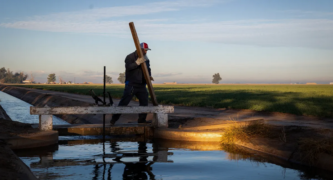Their grinding struggles have been underway for as long as California has been a state (173 years), but on occasions – sometimes separated by decades – major actions change California’s waterscape.
This appears to be one of those occasions. California’s recent experience of drought followed by torrential rain and snow storms seems to have jolted water stakeholders into doing things that seemed impossible just a few years ago.
California’s users of Colorado River water, principally the Imperial Irrigation District, last week formally signed an agreement with other states to reduce diversions from the much-troubled river. It’s hoped that the deal will stave off an otherwise imminent catastrophe in the rivers two major reservoirs, Lake Powell and Lake Mead.
Federal officials pressed for the historic agreement, threatening unilateral cuts if it didn’t happen, and lubricated it with many millions of dollars in compensation.
The state Department of Water Resources has released a final environmental impact report on a plan to bore a tunnel beneath the Sacramento-San Joaquin Delta and carry some Sacramento River water to the head of the California Aqueduct without pulling water from the Delta itself.
Versions of the bypass have kicked around for more than six decades, with officialdom saying it’s needed to protect water supplies to the San Joaquin Valley and Southern California and opponents, particularly environmental groups, saying it would worsen water quality in the Delta. Release of the report sets the stage for what could be years of political and legal battles before construction could begin.
Tunnel advocates say that water would be drawn only during periods of high precipitation and snowpack runoff to improve water reliability, which is also the rationale for another major construction project that’s languished for decades: the Sites reservoir in Colusa and Glenn counties. In November, Gov. Gavin Newsom designated Sites for streamlined approval of a final environmental impact report, paving the way for construction that could begin as soon as 2025.
In October, the federal Bureau of Reclamation announced the approval of a storage capacity expansion plan for the San Luis Reservoir, a key element of California’s water supply system. San Luis, in the Pacheco Pass, is an off-stream reservoir that absorbs water drawn from the Sacramento-San Joaquin Delta and stores it to meet later demands. It’s similar to how the proposed Sites reservoir would function – storing water when it’s available to cushion periods when natural flows are diminished. The plan would increase the reservoir’s capacity by 130,000 acre-feet.
Finally, the state water regulators are poised to approve first-ever projects that directly convert sewage into drinking water. Reusing water “gives us a supply that in essence is always going to be there,” Darrin Polhemus, a water board deputy director, said.
While important, these recent developments don’t end California’s water wars. For instance, the state is beginning to implement first-ever controls on pumping from underground aquifers under a law passed a decade ago, which could sharply affect agriculture production in the San Joaquin Valley.
Meanwhile, the water buffaloes are gearing up for the most divisive of all potential conflicts – whether the state will breach water rights, some of which date back to the Gold Rush days. Preliminary skirmishes are already underway, as the New York Times detailed last week.
It will be epic.
CalMatters.org is a nonprofit, nonpartisan media venture explaining California policies and politics.















 0 comments
0 comments


